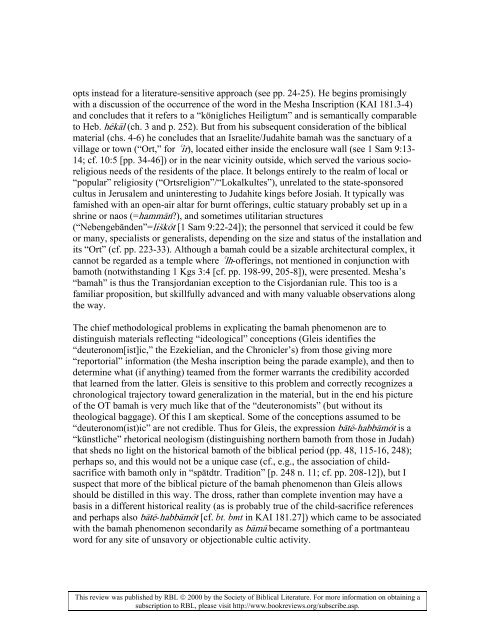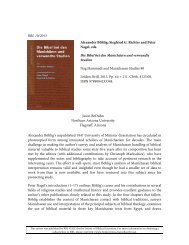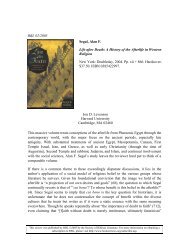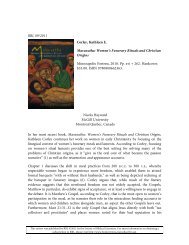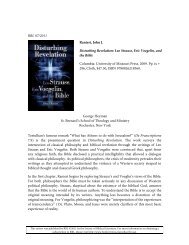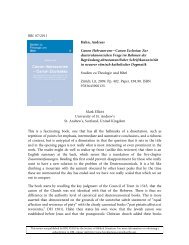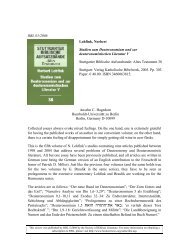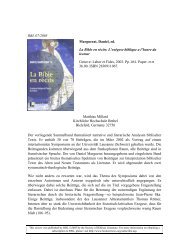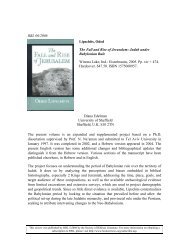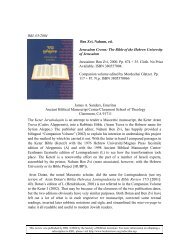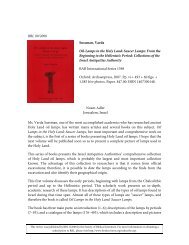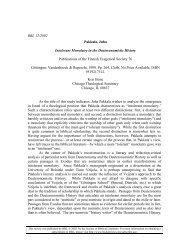RBL 09/04/2000 Gleis, Matthias. Die Bamah Beihefte zur Zeitschrift ...
RBL 09/04/2000 Gleis, Matthias. Die Bamah Beihefte zur Zeitschrift ...
RBL 09/04/2000 Gleis, Matthias. Die Bamah Beihefte zur Zeitschrift ...
You also want an ePaper? Increase the reach of your titles
YUMPU automatically turns print PDFs into web optimized ePapers that Google loves.
opts instead for a literature-sensitive approach (see pp. 24-25). He begins promisingly<br />
with a discussion of the occurrence of the word in the Mesha Inscription (KAI 181.3-4)<br />
and concludes that it refers to a “königliches Heiligtum” and is semantically comparable<br />
to Heb. he=ka4l (ch. 3 and p. 252). But from his subsequent consideration of the biblical<br />
material (chs. 4-6) he concludes that an Israelite/Judahite bamah was the sanctuary of a<br />
village or town (“Ort,” for (i=r), located either inside the enclosure wall (see 1 Sam 9:13-<br />
14; cf. 10:5 [pp. 34-46]) or in the near vicinity outside, which served the various socioreligious<br />
needs of the residents of the place. It belongs entirely to the realm of local or<br />
“popular” religiosity (“Ortsreligion”/“Lokalkultes”), unrelated to the state-sponsored<br />
cultus in Jerusalem and uninteresting to Judahite kings before Josiah. It typically was<br />
famished with an open-air altar for burnt offerings, cultic statuary probably set up in a<br />
shrine or naos (=hamma4n?), and sometimes utilitarian structures<br />
(“Nebengebänden”=lis]ko=t [1 Sam 9:22-24]); the personnel that serviced it could be few<br />
or many, specialists or generalists, depending on the size and status of the installation and<br />
its “Ort” (cf. pp. 223-33). Although a bamah could be a sizable architectural complex, it<br />
cannot be regarded as a temple where (lh-offerings, not mentioned in conjunction with<br />
bamoth (notwithstanding 1 Kgs 3:4 [cf. pp. 198-99, 205-8]), were presented. Mesha’s<br />
“bamah” is thus the Transjordanian exception to the Cisjordanian rule. This too is a<br />
familiar proposition, but skillfully advanced and with many valuable observations along<br />
the way.<br />
The chief methodological problems in explicating the bamah phenomenon are to<br />
distinguish materials reflecting “ideological” conceptions (<strong>Gleis</strong> identifies the<br />
“deuteronom[ist]ic,” the Ezekielian, and the Chronicler’s) from those giving more<br />
“reportorial” information (the Mesha inscription being the parade example), and then to<br />
determine what (if anything) teamed from the former warrants the credibility accorded<br />
that learned from the latter. <strong>Gleis</strong> is sensitive to this problem and correctly recognizes a<br />
chronological trajectory toward generalization in the material, but in the end his picture<br />
of the OT bamah is very much like that of the “deuteronomists” (but without its<br />
theological baggage). Of this I am skeptical. Some of the conceptions assumed to be<br />
“deuteronom(ist)ic” are not credible. Thus for <strong>Gleis</strong>, the expression ba4te=-habba4mo=t is a<br />
“künstliche” rhetorical neologism (distinguishing northern bamoth from those in Judah)<br />
that sheds no light on the historical bamoth of the biblical period (pp. 48, 115-16, 248);<br />
perhaps so, and this would not be a unique case (cf., e.g., the association of childsacrifice<br />
with bamoth only in “spätdtr. Tradition” [p. 248 n. 11; cf. pp. 208-12]), but I<br />
suspect that more of the biblical picture of the bamah phenomenon than <strong>Gleis</strong> allows<br />
should be distilled in this way. The dross, rather than complete invention may have a<br />
basis in a different historical reality (as is probably true of the child-sacrifice references<br />
and perhaps also ba4te=-habba4mo=t [cf. bt. bmt in KAI 181.27]) which came to be associated<br />
with the bamah phenomenon secondarily as ba4ma= became something of a portmanteau<br />
word for any site of unsavory or objectionable cultic activity.<br />
This review was published by <strong>RBL</strong> © <strong>2000</strong> by the Society of Biblical Literature. For more information on obtaining a<br />
subscription to <strong>RBL</strong>, please visit http://www.bookreviews.org/subscribe.asp.


